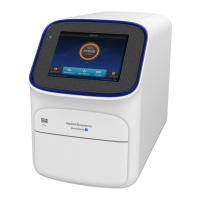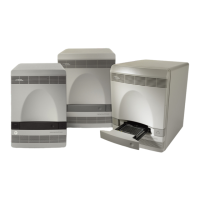In the thermal prole, a stage that is repeated. A cycling stage is also called an
amplication stage.
See also “amplication stage“ on page 184.
During the instrument run, a process in which an instrument detects uorescence
data from each w
ell of the plate or array card. The instrument transforms the signal to
electronic data and saves the data in the experiment le.
See “baseline-corrected normalized reporter (ΔRn)“ on page 185.
The default view of the melting curve. It plots the negative derivative data (–R
n
′ ) vs.
temperature.
Note: An alternative view is the raw data view, which plots the normalized
uorescence from reporter dye vs. temperature.
The rate of change in uorescence as a function of temperature. R
n
′ is used to plot a
melting curve. Signicant decrease of the uorescent signal generates a positive peak
on the derivative view of the melting curve.
See “melt curve“ on page 187.
Type of calibration in which the software collects spectral data from a series of dye
standards and stores the spectral information for the dye standards in a pure spectra
calibration le. This le is used during experiment runs to characterize and
distinguish the individual contribution of each dye in the total uorescence collected
by the instrument.
See “amplication eciency (EFF%)“ on page 184.
The standard error of the slope of the regression line in the standard curve.
The error can be used to calculate a condence interval (CI) for the slope. Because the
amplication eciency is calculated from the slope, knowing the error allows a CI for
the amplication eciency to be calculated.
Refers to the entire process of performing a run, including setup, run, and analysis.
Dye excitation and emission lter combination that is set for a experiment. The
QuantStudio
™
7 Flex System includes a decoupled, six by six-color lter set. The
QuantStudio
™
6 Flex System includes a coupled ve-color lter set. The excitation and
emission lter combinations are preset by the experiment document (.eds) le for
your experiment.
A quality control (QC) indicator which, when applied by the software to a well during
analysis, indicates a possible issue with that reaction. For example, a ag may be
issued if no amplication is detected in a well. Flags indicating potential problems are
displayed in the Quality Control tab of the Plate Layout, Well Table, and QC
Summary screens.
cycling stage
data collection
delta R
n
(ΔR
n
)
derivative melt
curv
e plot
derivative reporter
(–R
n
′ )
dissociation curve
dye calibration
EFF%
error
experiment
filter
flag
Limited product warranty
186
QuantStudio
™
6 and 7 Flex Real-Time PCR Systems v1.6 Maintenance and Administration Guide
